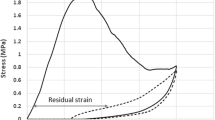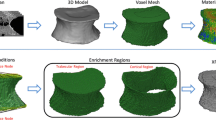Abstract
The ability to rapidly detect localised fractures of cortical and/or trabecular bone sustained by the vertebral body would enhance the analysis of vertebral fracture initiation and propagation during dynamic loading. In this study, high rate axial compression tests were performed on twenty sets of three-vertebra lumbar spine specimens. Acoustic Emission (AE) sensor measurements of sound wave pressure were used to classify isolated trabecular fractures and severe compressive fractures of vertebral body cortical and trabecular bone. Fracture detection using standard AE parameters was compared to that of traditional mechanical parameters obtained from load cell and displacement readings. Results indicated that the AE parameters achieved slightly enhanced classification of isolated trabecular fractures, whereas the mechanical parameters better identified combined fractures of cortical and trabecular bone. These findings demonstrate that AE may be used to promptly and accurately identify localised fractures of trabecular bone, whereas more extensive fractures of the vertebral body are best identified by load cell readings due to the considerable loss in compressive resistance. The discrimination thresholds corresponding to the AE parameters were based on calibrated measurements of AE wave pressure and may ultimately be used to examine the onset and progression of vertebral fracture in other loading scenarios.








Similar content being viewed by others
References
Agcaoglu, S., and O. Akkus. Acoustic emission based monitoring of the microdamage evolution during fatigue of human cortical bone. J. Biomech. Eng. 135:081005, 2013.
Aggelis, D. G., M. Strantza, O. Louis, F. Boulpaep, D. Polyzos, and D. van Hemelrijck. Fracture of human femur tissue monitored by acoustic emission sensors. Sensors 15:5803–5819, 2015.
Arun, M. W. J., N. Yoganandan, B. D. Stemper, and F. A. Pintar. A methodology to condition distorted acoustic emission signals to identify fracture timing from human cadaver spine impact tests. J. Mech. Behav. Biomed. Mater. 40:156–160, 2014.
Burge, R., B. Dawson-Hughes, D. H. Solomon, J. B. Wong, A. King, and A. Tosteson. Incidence and economic burden of osteoporosis-related fractures in the United States, 2005–2025. J. Bone Miner. Res. 22:465–475, 2007.
Carretta, R., S. Lorenzetti, and R. Müller. Towards patient-specific material modeling of trabecular bone post-yield behavior. Int. J. Numer. Methods Biomed. 29:250–272, 2013.
Christen, P., S. Boutroy, R. Ellouz, R. Chapurlat, and B. Van Rietbergen. Least-detectable and age-related local in vivo bone remodelling assessed by time-lapse HR-pQCT. PLoS ONE 13:1–11, 2018.
Christiansen, B. A., and M. L. Bouxsein. Biomechanics of vertebral fractures and the vertebral fracture cascade. Curr. Osteoporos. Rep. 8:198–204, 2010.
Cormier, J., S. Manoogian, J. Bisplinghoff, C. McNally, and S. Duma. The use of acoustic emission in facial fracture detection. Biomed. Sci. Instrum. 44:147–152, 2008.
Crawford, R. P., C. E. Cann, and T. M. Keaveny. Finite element models predict in vitro vertebral body compressive strength better than quantitative computed tomography. Bone 33:744–750, 2003.
Curry, W. H., F. A. Pintar, N. B. Doan, H. S. Nguyen, G. Eckardt, J. L. Baisden, D. J. Maiman, G. R. Paskoff, B. S. Shender, and B. D. Stemper. Lumbar spine endplate fractures: biomechanical evaluation and clinical considerations through experimental induction of injury. J. Orthop. Res. 34:1084–1091, 2016.
Goodwin, B. D., F. A. Pintar, and N. Yoganandan. Acoustic emission signatures during failure of vertebra and long bone. Ann. Biomed. Eng. 45:1520–1533, 2017.
Griffin, J. Traceability of Acoustic Emission measurements for a proposed calibration method:classification of characteristics and identification using signal analysis. Mech. Syst. Signal Process. 50–51:757–783, 2015.
Hagen, E. M., S. A. Lie, T. Rekand, N. E. Gilhus, and M. Gronning. Mortality after traumatic spinal cord injury: 50 years of follow-up. J. Neurol. Neurosurg. Psychiatry 81:368–373, 2010.
Hansson, T., B. Roos, and A. L. F. Nachemson. The bone mineral content and ultimate compressive strength of lumbar vertebrae. Spine 5:46–55, 1980.
Hasegawa, K., M. Abe, T. Washio, and T. Hara. An experimental study on the interface strength between titanium mesh cage and vertebra in reference to vertebral bone mineral density. Spine 26:957–963, 2001.
Hasserius, R., M. K. Karlsson, B. Jónsson, I. Redlund-Johnell, and O. Johnell. Long-term morbidity and mortality after a clinically diagnosed vertebral fracture in the elderly-a 12- and 22-year follow-up of 257 patients. Calcif. Tissue Int. 76:235–242, 2005.
Hurrell, A. Voltage to pressure conversion: are you getting `phased’ by the problem? J. Phys. Conf. Ser. 1:57–62, 2004.
Jackman, T. M., A. I. Hussein, C. Curtiss, P. M. Fein, A. Camp, L. De Barros, and E. F. Morgan. Quantitative, 3D visualization of the initiation and progression of vertebral fractures under compression and anterior flexion. J. Bone Miner. Res. 31:777–788, 2016.
Juszczyk, M. M., L. Cristofolini, M. Salvà, L. Zani, E. Schileo, and M. Viceconti. Accurate in vitro identification of fracture onset in bones: failure mechanism of the proximal human femur. J. Biomech. 46:158–164, 2013.
Landham, P. R., S. J. Gilbert, H. L. A. Baker-Rand, P. Pollintine, K. A. R. Brown, M. A. Adams, and P. Dolan. Pathogenesis of vertebral anterior wedge deformity: a 2-stage process? Spine 40:902–908, 2015.
Lane, N. E., M. C. Nevitt, H. K. Genant, and M. C. Hochberg. Reliability of new indices of radiographic osteoarthritis of the hand and hip and lumbar disc degeneration. J. Rheumatol. 20:1911–1918, 1993.
Lin, W., F. Serra-Hsu, J. Cheng, and Y.-X. Qin. Frequency specific ultrasound attenuation is sensitive to trabecular bone structure. Ultrasound Med. Biol. 38:2198–2207, 2012.
Liu, P. F., J. K. Chu, Y. L. Liu, and J. Y. Zheng. A study on the failure mechanisms of carbon fiber/epoxy composite laminates using acoustic emission. Mater. Des. 37:228–235, 2012.
Martelli, S., and E. Perilli. Time-elapsed synchrotron-light microstructural imaging of femoral neck fracture. J. Mech. Behav. Biomed. Mater. 84:265–272, 2018.
Mattes, D., D. R. Haynor, H. Vesselle, T. K. Lewellen, and W. Eubank. PET-CT image registration in the chest using free-form deformations. IEEE Trans. Med. Imaging 22:120–128, 2003.
Morgan, E. F., H. H. Bayraktar, and T. M. Keaveny. Trabecular bone modulus-density relationships depend on anatomic site. J. Biomech. 36:897–904, 2003.
Ochia, R. S., and R. P. Ching. Internal pressure measurements during burst fracture formation in human lumbar vertebrae. Spine 27:1160–1167, 2002.
Panjabi, M. M., T. R. Oxland, M. Kifune, M. Arand, L. Wen, and A. Chen. Validity of the three-column theory of thoracolumbar fractures. A biomechanic investigation. Spine 20:1122–1127, 1995.
Pickett, G. E., M. Campos-Benitez, J. L. Keller, and N. Duggal. Epidemiology of traumatic spinal cord injury in Canada. Spine 31:799–805, 2006.
Sasso, M., G. Haïat, Y. Yamato, S. Naili, and M. Matsukawa. Frequency dependence of ultrasonic attenuation in bovine cortical bone: an in vitro study. Ultrasound Med. Biol. 33:1933–1942, 2007.
Shridharani, J. K., B. R. Bigler, C. A. Cox, M. A. Ortiz-Paparoni, and C. R. Bass. Sensitive injury detection in the cervical spine using acoustic emission and continuous wavelet transform. In: IRCOBI Conference 2016, Malaga, Spain, pp. 131–142, 2016. http://www.ircobi.org/wordpress/downloads/irc16/pdf-files/24.pdf.
Stemper, B. D., S. Chirvi, N. Doan, J. L. Baisden, D. J. Maiman, W. H. Curry, N. Yoganandan, F. A. Pintar, G. Paskoff, and B. S. Shender. Biomechanical tolerance of whole lumbar spines in straightened posture subjected to axial acceleration. J. Orthop. Res. 36:1747–1756, 2017.
Stemper, B. D., S. G. Storvik, N. Yoganandan, J. L. Baisden, R. J. Fijalkowski, F. A. Pintar, B. S. Shender, and G. R. Paskoff. A new PMHS model for lumbar spine injuries during vertical acceleration. J. Biomech. Eng. 133:081002, 2011.
Stemper, B. D., N. Yoganandan, J. L. Baisden, S. Umale, A. S. Shah, B. S. Shender, and G. R. Paskoff. Rate-dependent fracture characteristics of lumbar vertebral bodies. J. Mech. Behav. Biomed. Mater. 41:271–279, 2015.
Taddei, F., L. Cristofolini, S. Martelli, H. S. Gill, and M. Viceconti. Subject-specific finite element models of long bones: an in vitro evaluation of the overall accuracy. J. Biomech. 39:2457–2467, 2006.
Van Toen, C., J. Street, T. R. Oxland, and P. A. Cripton. Acoustic emission signals can discriminate between compressive bone fractures and tensile ligament injuries in the spine during dynamic loading. J. Biomech. 45:1643–1649, 2012.
Vasquez, K. B., F. T. Brozoski, K. P. Logsdon, and V. C. Chancey. Retrospective analysis of injuries in underbody blast events: 2007–2010. Mil. Med. 183:347–352, 2018.
Wells, J. G., and R. D. Rawlings. Acoustic emission and mechanical properties of trabecular bone. Biomaterials 6:218–224, 1985.
Wenzel, T. E., M. B. Schaffler, and D. P. Fyhrie. In vivo trabecular microcracks in human vertebral bone. Bone 19:89–95, 1996.
Willén, J., S. Lindahl, L. Irstam, B. Aldman, and A. Nordwall. The thoracolumbar crush fracture an experimental study on instant axial dynamic loading: The resulting fracture type and its stability. Spine 9:624–631, 1984.
Yeh, O. C., and T. M. Keaveny. Relative roles of microdamage and microfracture in the mechanical behavior of trabecular bone. J. Orthop. Res. 19:1001–1007, 2001.
Yoganandan, N., J. Moore, F. A. Pintar, A. Banerjee, N. DeVogel, and J. Zhang. Role of disc area and trabecular bone density on lumbar spinal column fracture risk curves under vertical impact. J. Biomech. 72:90–98, 2018.
Yoganandan, N., F. A. Pintar, B. D. Stemper, J. L. Baisden, R. Aktay, B. S. Shender, G. Paskoff, and P. Laud. Trabecular bone density of male human cervical and lumbar vertebrae. Bone 39:336–344, 2006.
Zhao, F. D., P. Pollintine, B. D. Hole, M. A. Adams, and P. Dolan. Vertebral fractures usually affect the cranial endplate because it is thinner and supported by less-dense trabecular bone. Bone 44:372–379, 2009.
Acknowledgments
The authors would like to acknowledge the support from Defence Science and Technology Group, Australia and the collaboration with U.S. Army Research Laboratory for this research. We also acknowledge the facilities and scientific and technical assistance of the National Imaging Facility, a National Collaborative Research Infrastructure Strategy (NCRIS) capability, at Monash Biomedical Imaging, Monash University.
Author information
Authors and Affiliations
Corresponding author
Additional information
Associate Editor Stefan M. Duma oversaw the review of this article.
Publisher's Note
Springer Nature remains neutral with regard to jurisdictional claims in published maps and institutional affiliations.
Electronic supplementary material
Below is the link to the electronic supplementary material.
Rights and permissions
About this article
Cite this article
Robinson, D.L., Tse, K.M., Franklyn, M. et al. Cortical and Trabecular Bone Fracture Characterisation in the Vertebral Body Using Acoustic Emission. Ann Biomed Eng 47, 2384–2401 (2019). https://doi.org/10.1007/s10439-019-02316-y
Received:
Accepted:
Published:
Issue Date:
DOI: https://doi.org/10.1007/s10439-019-02316-y




